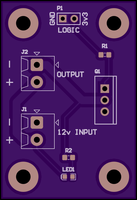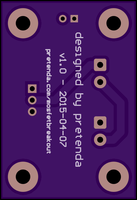So I had a few hours free tonight to be able to build up one of the breakout boards. I know I said I would be working on the power supply next, but I lied. Deal with it.
I've been looking at different transformers that are out there, and have found 3 different types. Iron core, switching and an LED driver. For now, my goal is to get an iron core transformer working. Switching transformers generally have a minimum load that needs to be available before they turn on, which will make life difficult. LED drivers are generally designed to work specifically with the light they are bundled with. I am sure that there are some other options out there that provide a straight 12v source, but I haven't gotten my hands on one yet.
In any case, the source voltage on (at least) two of the above options is approx. 12vac. Part of the power supply is going to have to be a bridge rectifier to give me a DC voltage for my circuit logic. I figure, why not make the rectifier a bit more beefy and change all of the power over to DC? This will let me work with a standard N channel MOSFET to switch and dim the light on/off.
Anyway, here is my first attempt at building a circuit with a MOSFET in it. It is super simple, but once again, it is a building block not just for this project, but for any of my projects in the future that require switching. There is a simple LED onboard that allows you to see the status of the MOSFET without having a full light connected up to it. It is powered from the 12V rail.
The components required are:
R1: 100R 0603 Resistor
R2: 1K 0603 Resistor
LED1: 0603 Green LED
Q1: FQP30N06L N Channel MOSFET
J1, J2: http://www.digikey.com.au/product-detail/en/1776113-2/A97976-ND/1826839
P1: Standard 2.54mm header


Here is a link to the board on dirtyPCBs if you would like to order it. I greatly appreciate it if you buy them using the link here, it gives me $1 towards future prototype boards. In any case, the board hasn't been tested yet. When they arrive, I will post an update with my results.
Next up is the power supply. I need to get all of the parts as breadboard-able components so that I can have a play around with them before I send off a board for manufacture.
 Matt
Matt
Discussions
Become a Hackaday.io Member
Create an account to leave a comment. Already have an account? Log In.